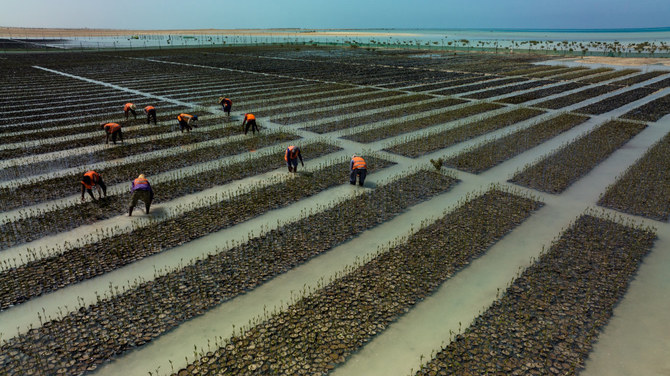
- ARAB NEWS
- 06 Jul 2025

RIYADH: Red Sea Global has launched an ambitious nursery project to grow 50 million mangrove trees in Saudi Arabia by 2030.
The project is part of Saudi Arabia’s mission to promote sustainability and biodiversity.
According to a report by Al Arabiya, John Pagano, CEO of Red Sea Global, said: “Our mangrove nursery will increase the numbers of mangroves and boost biodiversity, ensuring we reach the environmental ambitions we have set ourselves.”
Mangroves are a species of tree that grows in coastal intertidal zones, boasting among the highest ratio of carbon dioxide absorption compared to other species of trees.
They have the capacity to store large amounts of CO2 derived from the atmosphere — about 200 to 2,000 metric tons per hectare over a period of 50 years.

Some experts have suggested that mangroves can isolate carbon at rates two to four times higher than tropical rainforests.
Mangroves enhance biodiversity, and often become home to turtles, fish, snails, birds and seabirds, as well as various marine lifeforms.
Due to the significant impact of mangrove trees on the sustainability of the ecosystem in Saudi Arabia, the salt-tolerant species have captured the attention of environment experts at Red Sea Global.
The initiative to grow 50 million mangrove trees by 2030 is part of the Saudi Green Initiative, which promotes carbon neutrality.
The trees can be seen in many locations along the Red Sea coast. They contribute to temperature regulation as well as natural desalination.
Briefly explaining the plantation process, Pagano said: “The seedlings will be cared for in the nursery for approximately eight months until they reach a height of 80 cm. During this time, our experts will closely monitor their growth and ensure their well-being.
“We have chosen to cultivate native mangrove species, such as the red mangrove and the gray mangrove. Once the seedlings have reached the appropriate height, we will carefully transplant them in designated mangrove parks within our destinations. These mangrove parks will not only contribute to the conservation of the Red Sea coastline, but will also serve as educational hubs for visitors to explore and learn about the important role mangroves play in natural ecosystems.
“The process of cultivating and transplanting mangrove trees requires significant planning and proficiency. The nurseries are strategically located near a water source within the intertidal zone — the area where the ocean meets the land between high and low tides — to ensure optimal growth.
“We meticulously track tide cycles to find periods of low tide and consistently monitor the weather to avoid windy days, ensuring the successful transplantation of the seedlings.”
Yasser Al-Mutairi, a Saudi environmental expert, told Arab News about the biology behind mangrove trees as well as the process of photosynthesis. Mangroves can flourish in saline water through specific physiological processes, he said.
Al-Mutairi highlighted the critical role of mangroves in stabilizing coastlines and supporting biodiversity. He believes that the tree species provide protection for marine and coastal life. The unique root system of mangrove trees and the complex arrangement of aboveground branches offer an assortment of micro-habitats for other species, he added.
The most common mangrove is the Avicennia marina, known as the grey or white mangrove. The species features prominently along the Red Sea coastline. Red mangroves, or Rhizophora mucronate, have shiny leaves and spread through viviparous seeds that germinate while still attached to the parent tree.
Prominent companies in the Kingdom have also launched mangrove-planting initiatives.
Aramco, for example, has planted more than 4.3 million mangrove trees along the Arabian Gulf and Red Sea coastlines. One of the company’s projects is the mangrove eco-park in Ras Tanura.